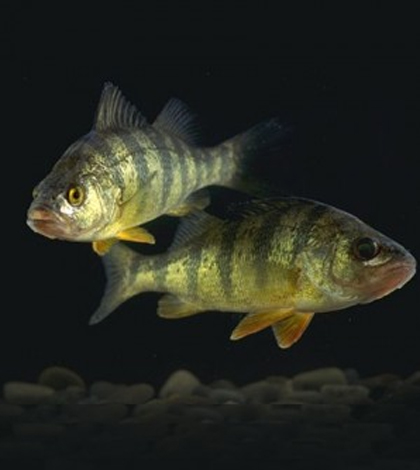Yellow Perch

Yellow perch. (Credit: U.S. Department of Agriculture)
Scientific Name: Perca flavescens
Common Name: Yellow perch
Yellow Perch Interesting Facts
- Yellow perch are a member of the perch family (Percidae).
- Yellow perch spawning is unique; they lay their eggs in long, connected ribbons.
- Yellow perch can reach a maximum length of about 16″ and weigh over 2 pounds.
- The Ohio state record yellow perch weighed 2.75 pounds and was caught on Lake Erie.
- Adult yellow perch diets include small fish and invertebrates, such as mayfly larvae.
Yellow Perch Distribution and Identification
Yellow perch are native to the upper Midwest and Canada, and usually have yellowish sides with dark vertical bars on their side and a white underside. They have sharp spines in their first dorsal fin, and their fins sometimes turn bright orange during spawning.
Yellow Perch Biology
Recently, yellow perch physiology has been a popular topic for research. Demand has increased for yellow perch as a food fish, and current commercial fisheries are not fulfilling the need. To increase the availability of yellow perch fillets, aquaculture researchers are documenting optimal conditions for culture of the species. The Ohio State University aquaculture lab is also completing some interesting research on topics such as out of season spawning and re-circulating systems.
Recent declines in Great Lakes populations has led to increased research, especially on Lake Michigan. The Wisconsin DNR is also considering actions to increase the Green Bay (Lake Michigan) yellow perch population. Lake Michigan is not the only Great Lake where anglers are concerned about the status of yellow perch. Although Lake Erie seems to still be producing plenty of yellow perch for sport fishing, there is concern that the same trends in other Great Lakes will start to show up. To read about Lake Erie yellow perch, click here.
Great Lake’s yellow perch populations (especially Lake Michigan) seem to be at a turning point. Exotic species introductions and other ecosystem changes appear to be negatively impacting yellow perch around the region. New research initiatives have been developed to understand the problem better, and state DNR management strategies have been developed to counteract the decreasing populations.
For more information about yellow perch, please visit:
- Wisconsin Sea Grant, yellow perch information page
Top image: Yellow perch. (Credit: U.S. Department of Agriculture)




0 comments